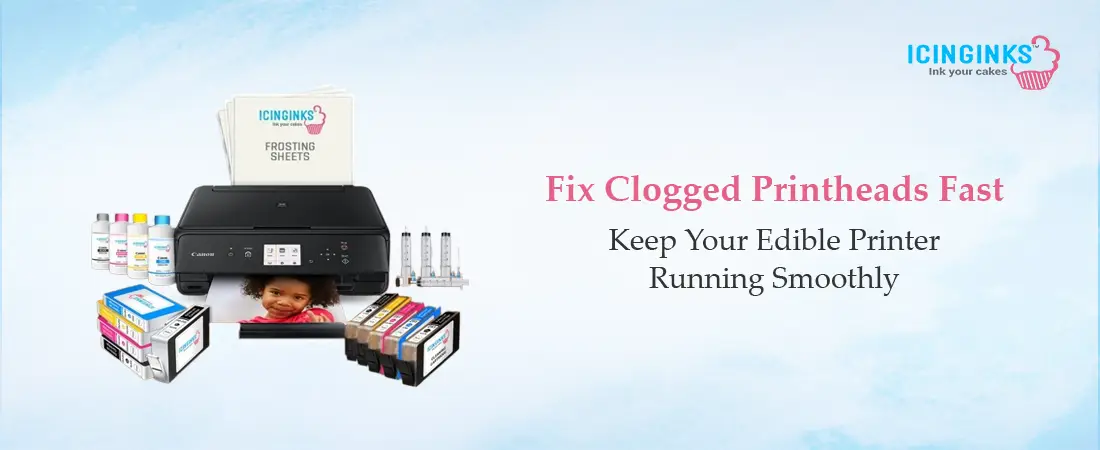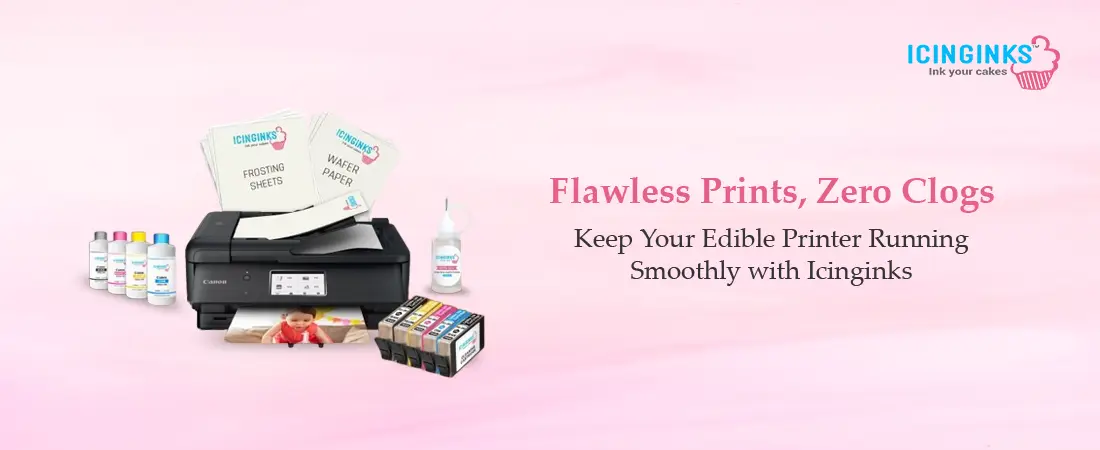
An edible printer is a fantastic tool for creating detailed images for cakes, cookies, and other desserts. However, like any inkjet printer, it requires proper maintenance to function smoothly. One of the most common issues users face is a clogged printhead, often caused by the unique composition of edible ink.
This guide will help you understand why printheads get clogged, how to identify the issue, and the best methods to clean and maintain your edible printer for long-term use.
Why Does the Printhead of an Edible Printer Get Clogged?
A printhead clog occurs when edible ink dries or solidifies inside the printer’s nozzles, preventing the smooth flow of ink. The most common reasons include:
- Infrequent Use – If the printer remains unused for an extended period, ink in the nozzles can dry up, leading to partial or complete clogging.
- Exposure to Extreme Temperatures – High temperatures can cause edible ink to evaporate, while cold temperatures can cause thickening, contributing to blockages.
- Improper Storage of Edible Ink Cartridges – Storing ink cartridges upright or exposing them to air can lead to dried ink particles at the nozzle openings.
- Use of Low-Quality or Expired Ink – Inferior edible ink may contain undissolved particles, increasing the risk of clogs. Expired ink can also lead to poor flow and buildup.
How to Identify a Clogged Printhead
Before cleaning the printhead, check for the following signs of a clog:
- Streaky or faded prints with dull or incomplete colors
- Vertical or horizontal lines appearing across printed images
- Missing colors in certain parts of the image
- Blank pages, despite the printer going through the motions of printing
If any of these issues are present, the printhead likely needs cleaning.
Method 1: Automatic Printhead Cleaning
Most edible printers feature an internal cleaning function designed to unclog minor blockages. To perform an automatic cleaning cycle, follow these steps:
- Open Printer Settings – Go to Devices and Printers on your computer and locate the edible printer.
- Access the Maintenance Tab – Right-click the printer icon, select Properties, and navigate to the Maintenance tab.
- Run a Cleaning Cycle – Select Cleaning (for minor clogs) or Deep Cleaning (for stubborn blockages).
- Print a Test Page – After cleaning, print a test sheet to check if the issue is resolved. Repeat the process if necessary.
This method works well for minor clogs but may not be sufficient for severe blockages.
Method 2: Manual Printhead Cleaning
A manual deep clean may be required if automatic cleaning does not resolve the issue. This involves removing the printhead and flushing out dried edible ink buildup.
Materials Needed for Manual Cleaning
- Food-safe printhead cleaning solution
- The syringe or flush kit
- Cotton swabs or lint-free cloth
- Small container with warm water
- Gloves and paper towels
Steps for Manual Cleaning
- Turn Off and Unplug the Printer – Ensure the printer is completely powered down before handling the printhead.
- Remove the Printhead – Follow the manufacturer’s instructions to detach the printhead carefully.
- Rinse with Warm Water – Fill a container with warm (not hot) water and soak the printhead for 10–15 minutes. Lightly shake the container to dissolve any dried edible ink.
- Apply Cleaning Solution – Using a syringe, push the cleaning fluid through the nozzle openings until the liquid flows smoothly.
- Let the Printhead Dry – Place the printhead on a clean, dry paper towel and allow it to air dry for at least 2–3 hours before reinstalling.
- Reinstall and Test Print – Once dry, reinstall the printhead, run a test print, and check the results.
Additional Tips to Prevent Printhead Clogging
- Print Regularly – Run a small test print every few days to keep the ink flowing.
- Store Cartridges Properly – Keep your edible ink cartridges in a cool, dry place to prevent ink evaporation or thickening.
- Use High-Quality Edible Ink – Use good-quality, food-grade ink for consistent performance.
- Keep Cartridges Sealed – When not in use, store cartridges in their original packaging to prevent drying.
By following these maintenance tips, you can keep your edible printer in excellent condition and minimize the risk of printhead blockages.
Final Thoughts
A clogged printhead can be frustrating, but your edible printer can consistently deliver high-quality prints with proper cleaning and maintenance. Regular care is essential for optimal performance, Whether automatic or manual deep cleaning or a manual deep clean. By integrating these maintenance practices, you can extend the lifespan of your printer and achieve flawless edible prints for your baking projects.
Keep Your Edible Printer in Peak Condition with Icinginks' Cleaning Solutions

Regular cleaning is essential to maintain the best performance of your edible printer. Icinginks offers edible cleaning cartridges with a food-grade cleaning solution that helps dissolve dried edible ink and prevent clogging. These cartridges are easy to install and work with multiple printer models, ensuring smooth and consistent prints.
For deeper cleaning, Icinginks provides a Printhead Cleaning Flush System with 120ml cleaning fluid, a syringe, tubes, and other accessories to manually flush out blockages. This system is perfect for restoring printheads affected by severe clogs.
Using Icinginks' cleaning products regularly can extend the lifespan of your edible printer, prevent print quality issues, and keep your edible designs looking flawless.
Essential Tips for Edible Printer Maintenance – A Must-Read!
Right Ways to Remove Clogging of Edible Printer for Their Better Life





